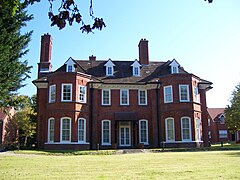Highgrove House, Eastcote
| Highgrove House | |
|---|---|

Highgrove House viewed from the east
|
|
|
Location within Greater London
|
|
| General information | |
| Architectural style | Queen Anne and Early Georgian |
| Location | Eastcote |
| Town or city | Greater London |
| Country | England |
| Coordinates | 51°34′54″N 0°24′28″W / 51.581667°N 0.407778°W |
| Construction started | 1747 (first house) 1879 (second house) |
| Completed | 1750 (first house) 1881 (second house) |
| Client | Reverend John Lidgould (first house) Sir Hugh Hume-Campbell (second house) |
| Design and construction | |
| Architect | Edward Prior (second house) |
Highgrove House, also known as High Grove House or High Grove, is a Grade II listed mansion in the suburban area of Ruislip, within the London Borough of Hillingdon. Originally built in 1750 by the Reverend John Lidgould, the house was rebuilt in 1881 by Sir Hugh Hume-Campbell following a catastrophic fire. Along with Haydon Hall and Eastcote House, Highgrove was one of the three main houses of Eastcote and eventually became a residential hostel for homeless families, run by the local council from the 1960s until 2007. An area of the estate was sold to the local council in 1935 by the then-owner Eleanor Warrender to become what is now Warrender Park. In 1975, the house was granted Grade II listed status on account of its special architectural character.
The house was subsequently closed as a hostel by the council and sold for £1.295m to Westcombe Estates. Planning permission was granted to the new owners in January 2007 for the conversion of the building into a luxury housing block of 12 units and expanded for a further three years in February 2010.
The site of the present house was originally owned and lived on by the Hale family in the 13th century. Reverend John Lidgould of Harmondsworth bought part of the land owned by Martha Hale and Elizabeth Kelly in 1747 and had the first house built.
Robert Turner bought the house and lived there from 1758; his son sold it in 1787 to the canon of Wells Cathedral, William Blencowe. John Humphrey Babb leased the house from the early 19th century, purchasing it outright from the Blencowe family in 1813. Upon his death in 1825, his successor as Deliverer of the Vote in the House of Commons, James Mitchell, moved to the house, living there until his own death in 1833. His widow subsequently sold Highgrove at auction.
In 1843, the house was bought by Lieutenant General Joseph Fuller. Days before his death, his daughter Juliana married Sir Hugh Hume-Campbell in October 1841. Ownership based to Fuller's daughter, the new Lady Hume-Campbell, although in 1879 the house was destroyed by fire. The Uxbridge Volunteer Fire Brigade with assistance from a pump provided by Pinner Hall were unable to save the building.
The ruins of the house were cleared following the fire, and Sir Hugh contracted Edward Schroeder Prior to design the new house, which was completed in 1881. Prior followed the Queen Anne and early Georgian architecture styles in his design, which is based around an "L" shape with an southern extension for the house's domestic services. Highgrove was built of red brick, with two storeys and an attic. The window arches were also made of brick. On the ground floor facing the gardens, three sets of three windows in bays were included. Prior's design drawings for the house were shown in an exhibition at the Royal Academy in 1882.
...
Wikipedia

